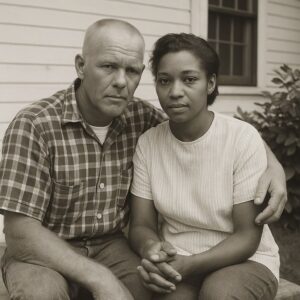Imagine living in a time when the simple act of marrying the person you love could land you in jail—just because of the color of their skin. This was the harsh reality for Richard and Mildred Loving, a couple whose love story would ultimately challenge and change the laws of an entire nation. On June 12, 1967, the U.S. Supreme Court made a landmark ruling in Loving v. Virginia that legalized interracial marriage across America, breaking down one of the most entrenched barriers of racial discrimination.
Richard Loving was a white man from Virginia, and Mildred Jeter was a Black and Native American woman. In 1958, after they married in Washington, D.C.—where interracial marriage was legal—they returned to their home state of Virginia. There, their marriage was illegal under the state’s anti-miscegenation laws, which banned interracial couples from marrying. Just weeks after their wedding, the Lovings were arrested in the middle of the night. Their crime? Simply being married. The law forced them to plead guilty and face a year in prison. But a judge gave them an unusual sentence: if they left Virginia and stayed away for 25 years, they could avoid jail time.
Imagine the weight of that sentence—exiled from your home and community simply because of who you chose to love. This painful reality sparked a quiet determination in the Lovings to fight back, setting in motion a legal battle that would reach the highest court in the land. Their case might have remained a personal tragedy if not for the efforts of the American Civil Liberties Union (ACLU), which took up their cause in 1963. The Lovings challenged the Virginia law, arguing that it violated their constitutional rights under the 14th Amendment, which guarantees equal protection under the law and due process.
For nearly a decade, their case worked its way through the courts. The central question: Could states deny couples the right to marry based solely on race? When the Supreme Court finally heard the case, the nation was already in the midst of sweeping social change. The civil rights movement was challenging segregation and discrimination in schools, public spaces, and voting rights. The Lovings’ case was part of this larger fight for equality and justice. On June 12, 1967, the Supreme Court ruled unanimously in favor of the Lovings. Chief Justice Earl Warren wrote the opinion declaring Virginia’s anti-miscegenation law unconstitutional. He stated plainly, “There is no legitimate overriding purpose independent of invidious racial discrimination which justifies this classification.” The ruling struck down all laws banning interracial marriage in the 16 states where such bans still existed. It was a powerful affirmation that marriage is a fundamental right, and that the government has no place in dictating whom people can or cannot love.
The Loving v. Virginia decision was far more than a legal win—it was a seismic cultural moment. It challenged deeply ingrained prejudices and social norms that had long upheld racial segregation. The ruling sent a message that love transcends race, and that equality under the law is not negotiable. But the story didn’t end there. The Lovings returned to Virginia and quietly resumed their lives, but their case ignited a wave of social change that would continue to influence generations. Interracial couples across the country could now marry without fear of legal persecution, and slowly but surely, the idea of love crossing racial boundaries became more accepted.
This ruling has also had a lasting impact far beyond just marriage laws. It laid the groundwork for future civil rights battles and showed that the Supreme Court could be a powerful agent for justice and social progress. It reminds us that laws are not just words on paper—they shape lives, communities, and the very fabric of society. The Lovings’ courage to fight for their right to love freely remains an inspiring example of how ordinary people can drive extraordinary change.
Today, the Loving v. Virginia case is often referenced in discussions about civil rights and marriage equality, including debates around same-sex marriage. It stands as a beacon of hope and progress, reminding us all that love is a universal human right that should never be denied or diminished.
In a world still grappling with division and inequality, the story of Richard and Mildred Loving is a powerful testament to the resilience of love and the ongoing fight for justice. Their legacy continues to teach us that change is possible when we stand up for what is right—even when the odds seem overwhelming.

